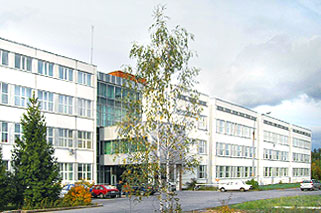About ISMAN
Address:
ISMANAcademician Osipyan str., 8
Chernogolovka
Moscow Region, 142432
Russia
E-mail:
isman@ism.ac.ruwebmaster@ism.ac.ru
Fax:
7 (49652) 46-2227 (49652) 46-255
Phone:
7 (49652) 46-376About ISMAN
Brief Information about ISMAN

The Institute of Structural Macrokinetics, Russian Academy of Sciences (Russian acronym ISMAN) is a young and developing research institution engaged in the studies on macroscopic kinetics of chemical reactions. Its scope of interests is associated with the processes of any chemical nature in which an important part is played by physical phenomena and events, such as heat/mass transfer, phase/structural transformations, etc. Theoretical and experimental studies of these processes, finding out positive and negative feedback between physical and chemical processes, and description of accompanying phenomena and events-all this defines a scientific approach to the studies carried out at the Institute. In this context, strongly exothermic processes, rich in macrokinetic effects, are of especial interest. For this reason, the theory and practice of combustion became a basis for the research work carried out at the Institute.
ISMAN (founded in 1987) is based on the Department of Macroscopic Kinetics at the Institute of Chemical Physics, USSR Academy of Sciences. At that time, the Institute united a team of young, like-minded researchers that used the macrokinetic approach in their theoretical and experimental studies and had acquired a taste for practical applications.
This team originated back in the mid fifties when a small group of investigators (A.G.Merzhanov, V.G.Abramov and V.V.Barzykin) was formed (at the Institute of Chemical Physics) to study thermal explosion in condensed systems, such as high explosives, gun powders, and solid propellants. In a short period, the theory of thermal explosion in condensed systems was developed, and appropriate experimental techniques for determining the parameters of thermal explosion were designed and manufactured.
Successful work of this research group has resulted in organizing a laboratory that was a part of the Institute of Chemical Physics in Chernogolovka, near Moscow. The scope of interests of this laboratory rapidly expanded. The ignition and propagation of the combustion wave became a new field of investigation. In addition, ever-growing interest was displayed in dispersed (particles, droplets, and their aggregates), macroheterogeneous (solid fuel agglomerates in a gaseous oxidant) systems, etc.
In the mid sixties, a new macrokinetic approach came on the scene. Pioneering studies on the theory of chemical reactors, nonisothermal polymerization, and thermal modes of heterogeneous catalytic reactions has been initiated.
An event that had a crucial impact on the further development of the laboratory took place in 1967. Modeling combustion in heterogeneous systems, a small research team (I.P.Borovinskaya, V.M.Shkiro, and A.G.Merzhanov) came to a scientific discovery officially termed the "solid flame phenomenon". Solid flame, at that time unbelievable, is a process in which starting reactants, intermediate products, and final products are present in their solid state throughout the entire process.
Solid flame combustion turned out to yield valuable refractory compounds. This circumstance has led to creating a novel, highly efficient production method-Self-propagating High-temperature Synthesis (SHS). This work opened new horizons for cognition and practical applications. Previously unknown systems, phenomena, processes, approaches to the problem, new task objectives, and potential applications began to emerge nearly every day. Combination of chemistry with macrokinetics has led to formulation of effective methodology and ideology for research and development in the field. This has led to important practical applications and, as recognition, to foundation of a new research unit, the Institute of Structural Macrokinetics.
In terms of this approach, the process is controlled not only by the rates of chemical reactions and heat/mass transfer (as in classical macrokinetics) but also by the kinetics of phase and structure transformations in the system. In other words, the processes of product formation (its composition, texture, structure, and properties) are now considered to be of great importance. All this naturally stimulated development of new materials, which gave an addition to the name of the Institute (since 1998, it is the Institute of Structural Macrokinetics and Materials Science).
Combination of the macrokinetic and materials studies has become a distinctive feature of the Institute.
Nowadays, R&D at ISMAN is going on along the following lines:
- theoretical models of structural macrokinetics
- general theory of autowave and induction processes
- experimental investigation of solid-flame combustion
- theory and practice of chain reactions
- new catalysts and heterogeneous catalysis
- new systems for combustion chemistry
- new experimental techniques
- impact of external influences on SHS
- SHS in multicomponent systems
- SHS production of powders, materials, and items;
- SHS coatings
- SHS joining
- materials science of SHS products
- etc.
The research work carried out at the Institute facilitates further integration of macrokinetics, chemistry, and technology.
The Institute is located in the township of Chernogolovka, 30 miles northeast of Moscow.
According to the order of FASO by August 1, 2017, from now on our institute should be officially referred to as Merzhanov Institute of Structural Macrokinetics and Materials Science, Russian Academy of Sciences
ISMAN News
- 24 Dec 2025 Поздравляем сотрудников ИСМАН с вручением наград!
- 15 Dec 2025 Поздравляем с юбилеем главного бухгалтера Татьяну Георгиевну Ермакову!
- 04 Dec 2025 Поздравляем Семенчука И.Е. с успешной защитой кандидатской диссертации!
ISMAN Website News
- 19 May 2025 Список публикаций лаборатории Физического материаловедения за 2023 г. и 2024 г.
- 04 Feb 2025
 Internal links:
Internal links:
* The results of the points calculation for the incentive researchers payments 2023/24 (2.18 Mb) - 28 Jan 2025
 Internal links:
Internal links:
* Points calculation for the incentive researchers payments 2023/24
